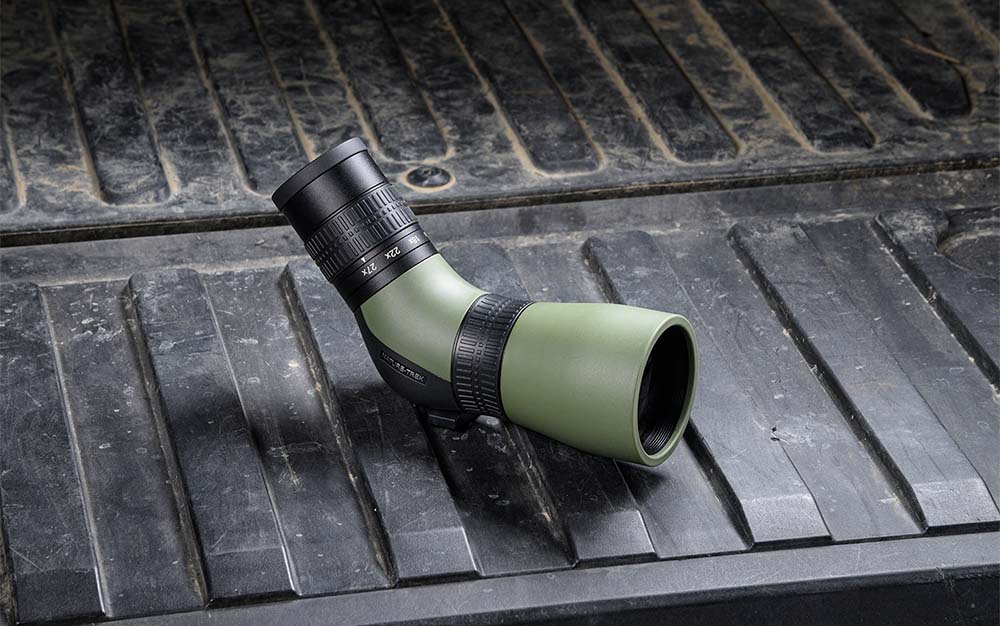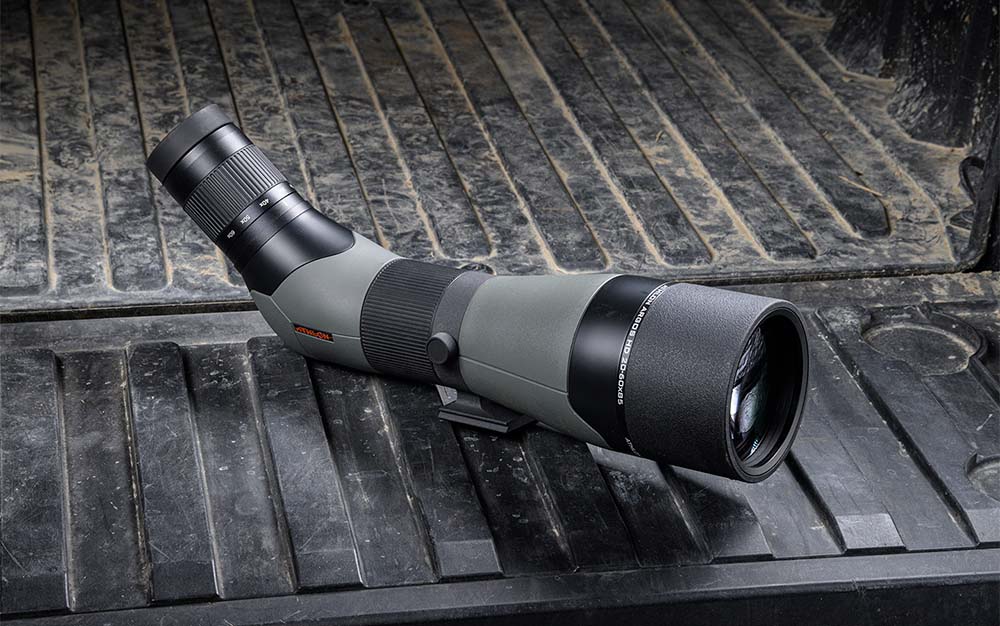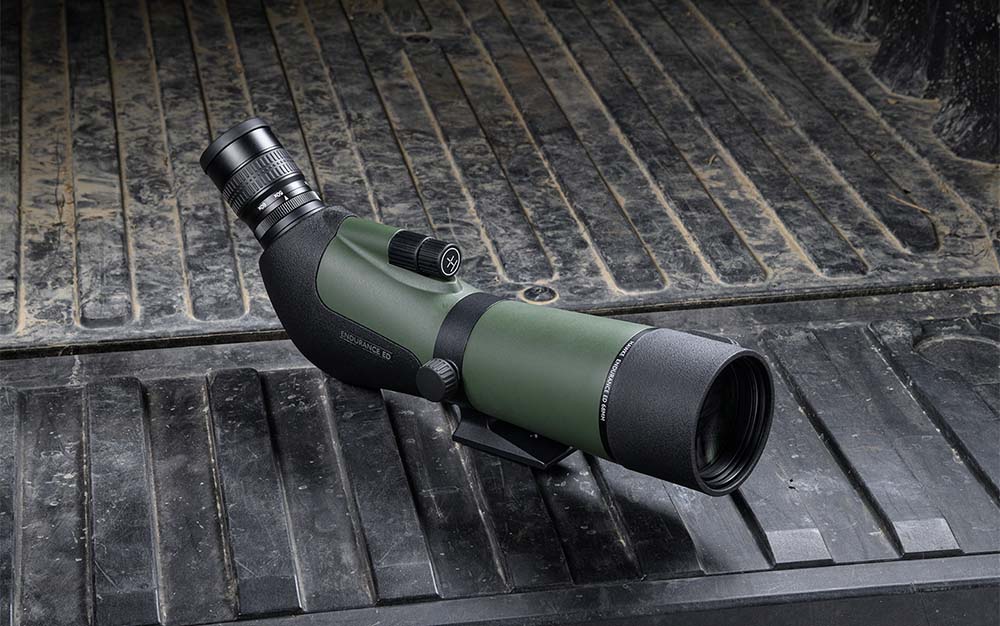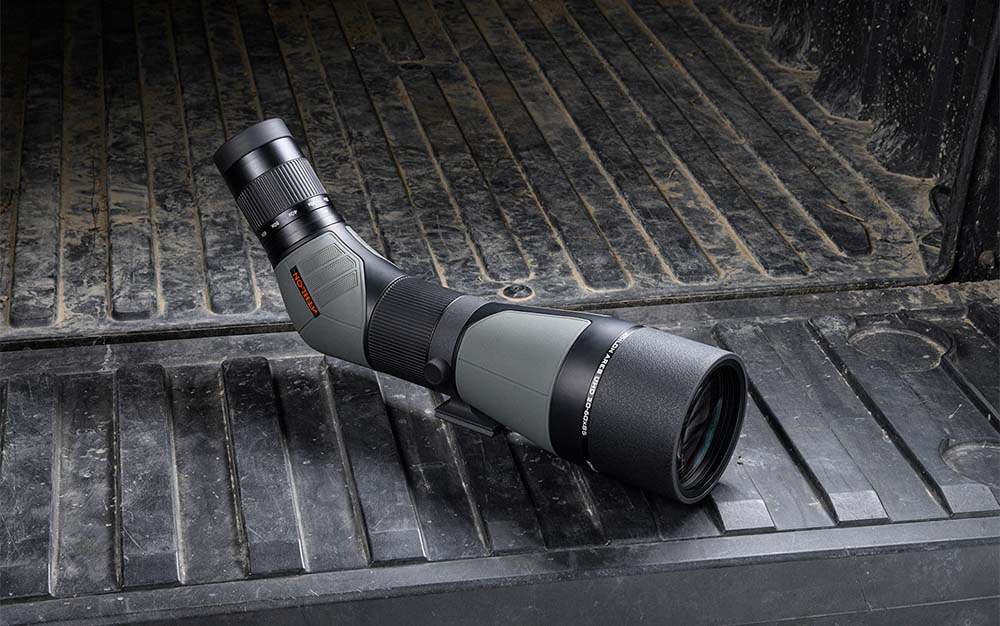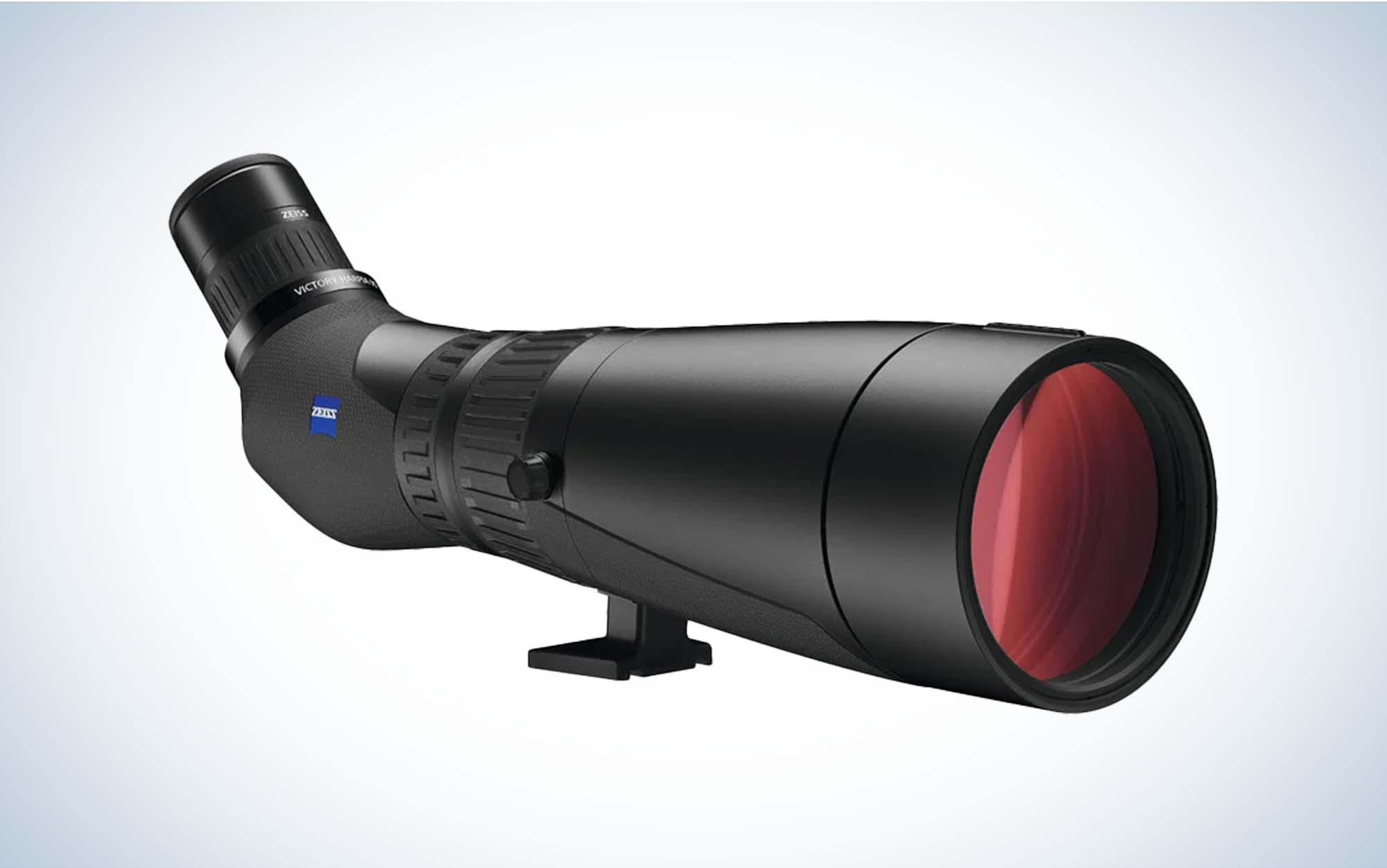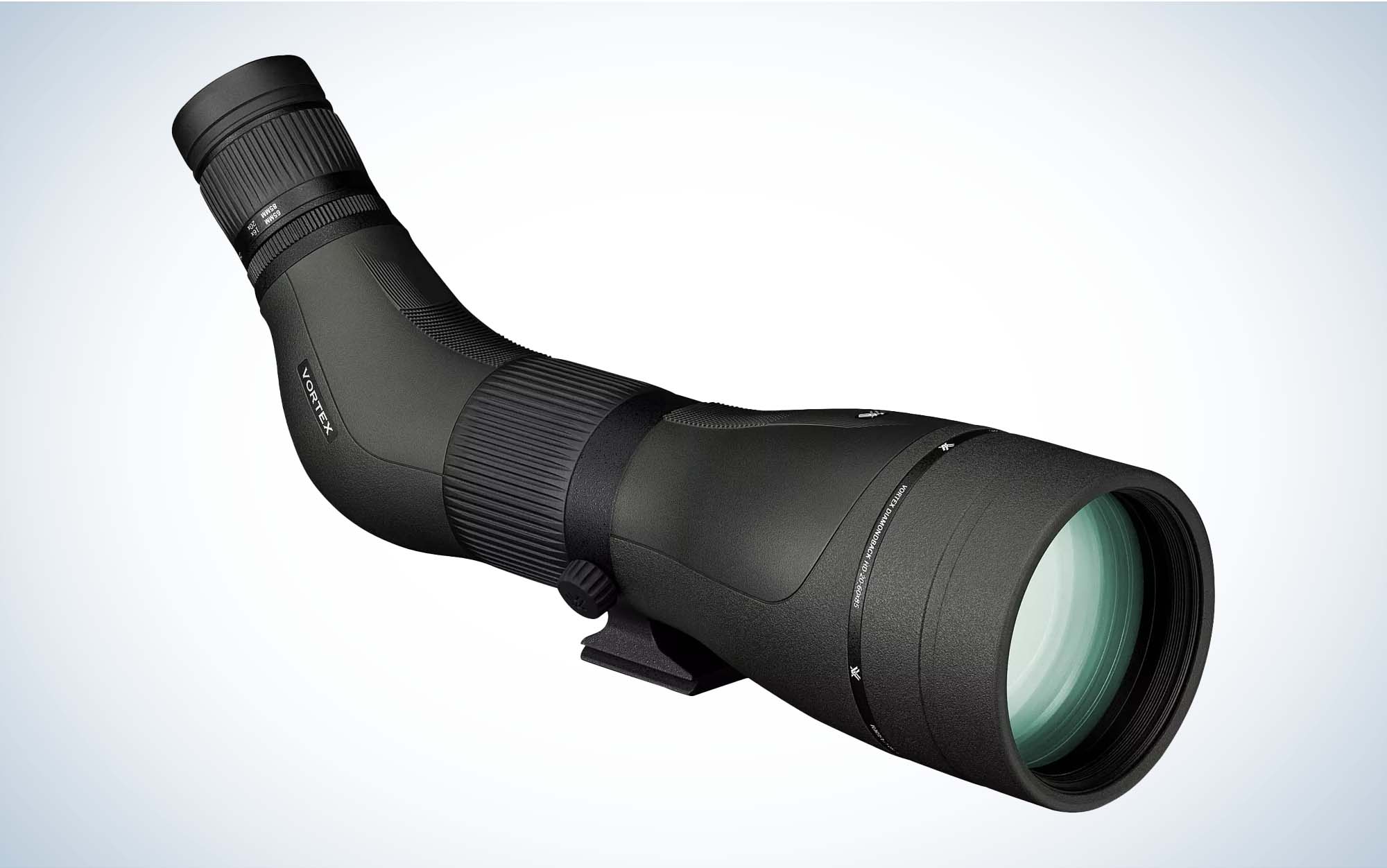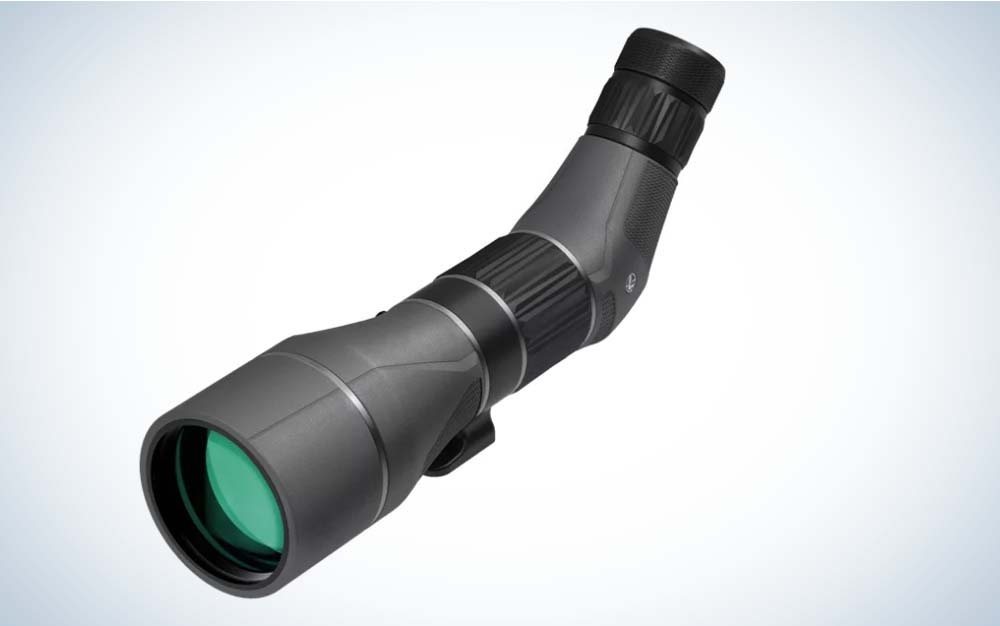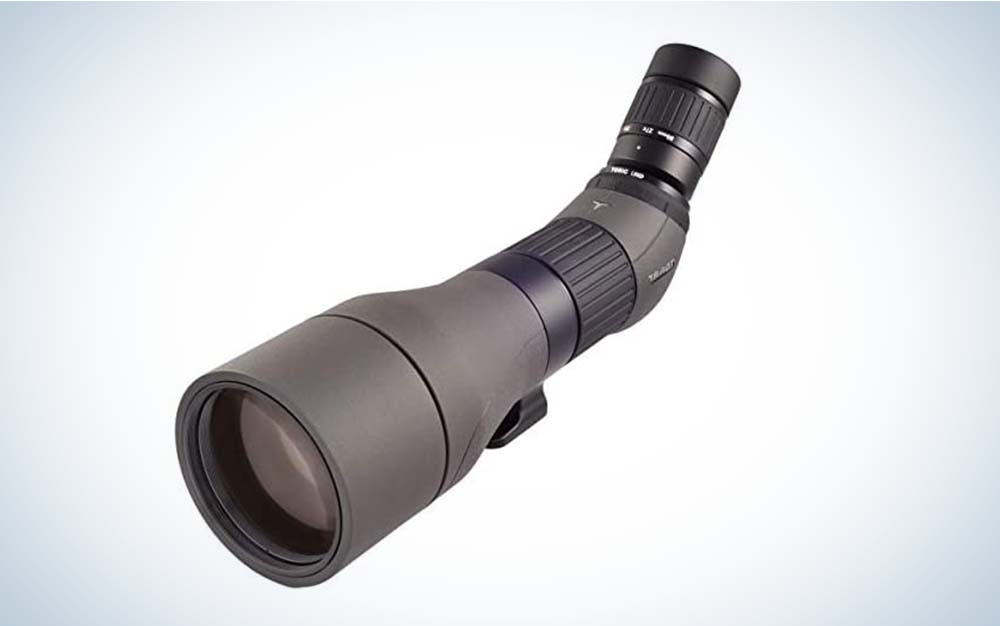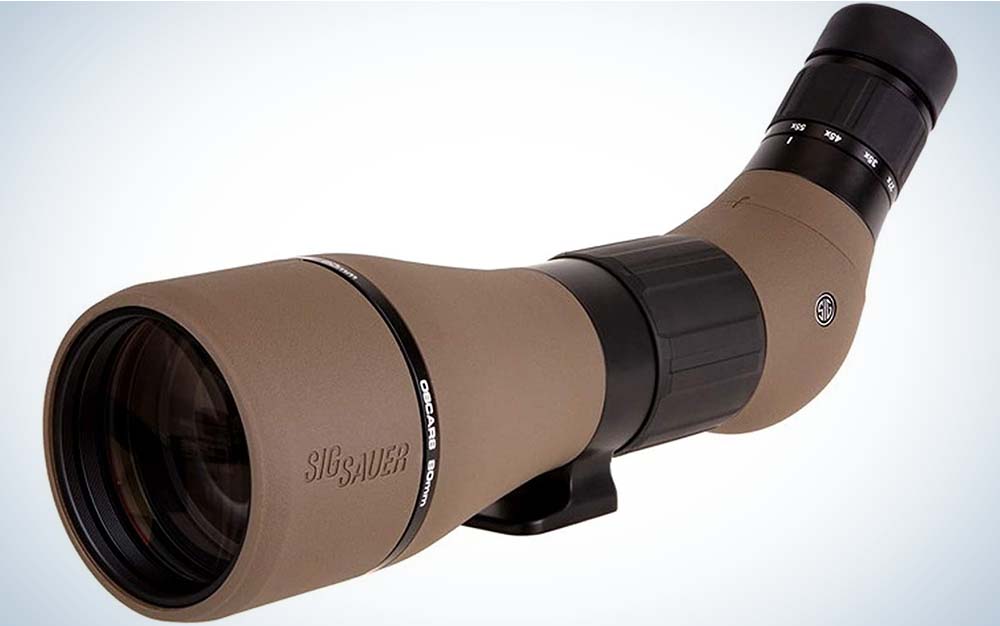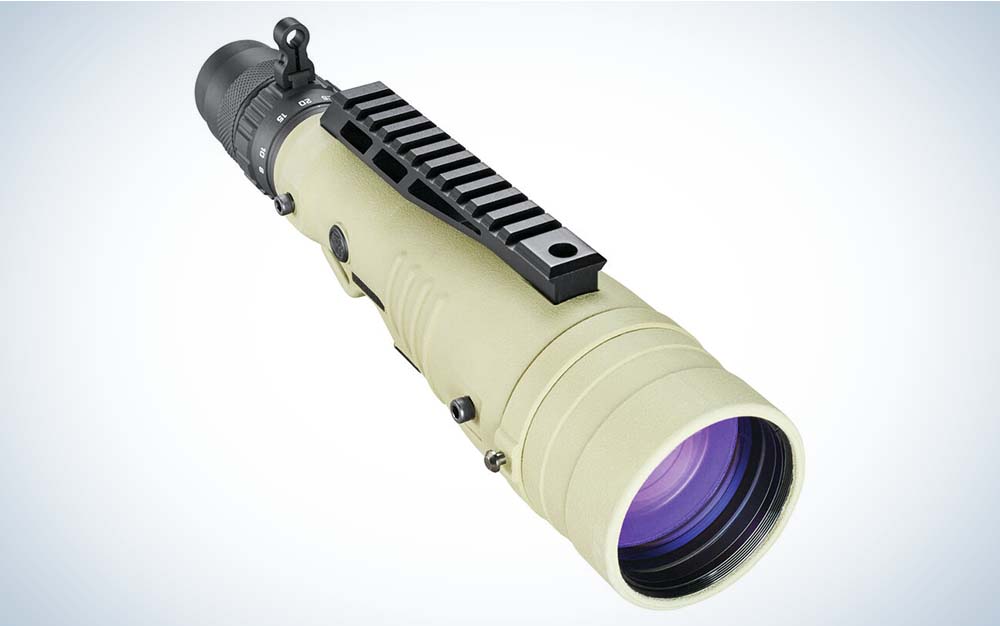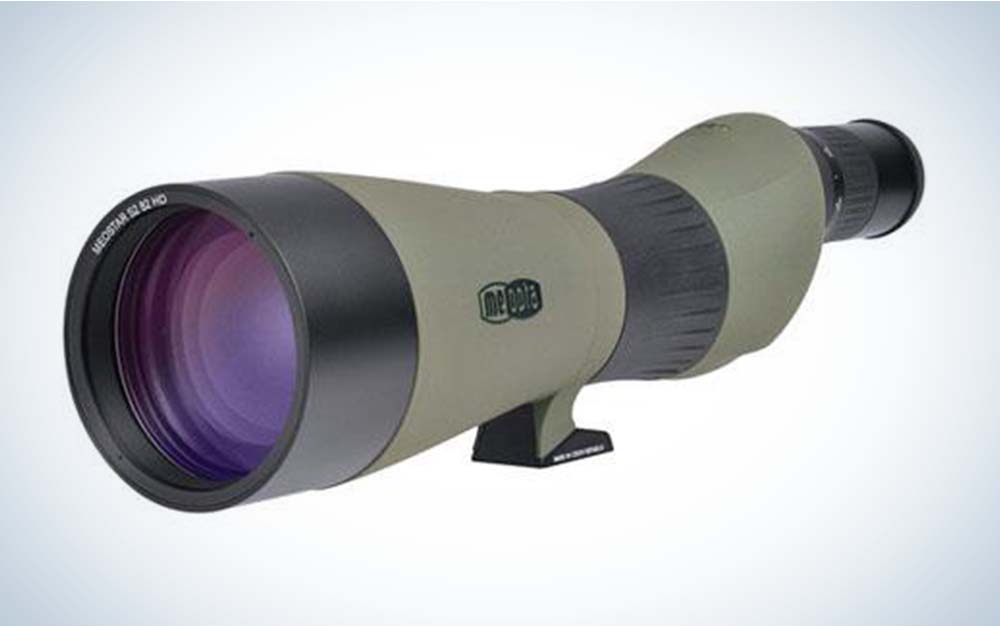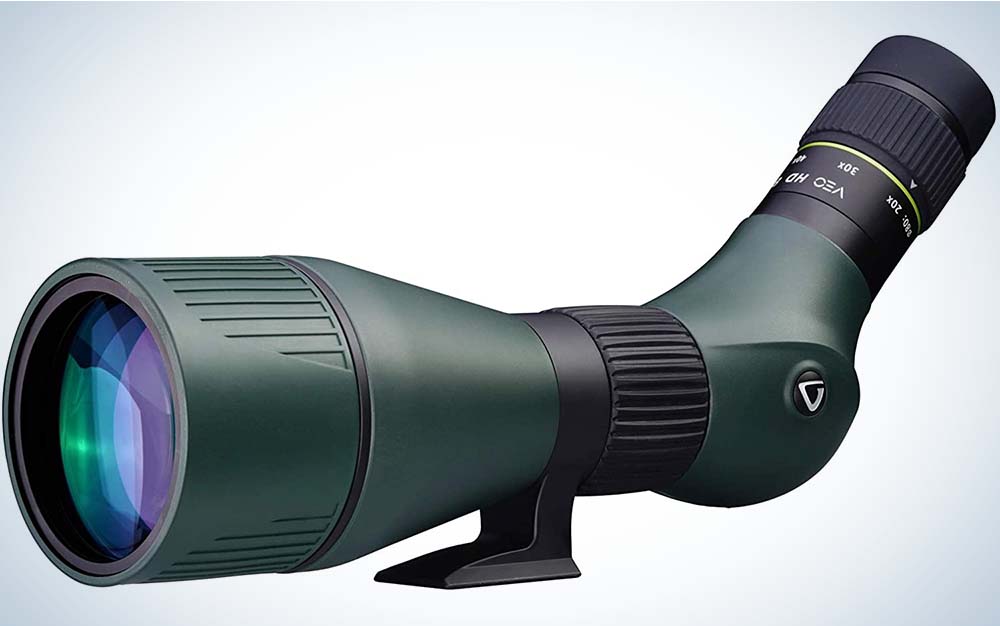We may earn revenue from the products available on this page and participate in affiliate programs. Learn More ›
Updated Apr 6, 2023 11:23 AM
This is not a particularly exciting year for spotting scopes. Only a few optics brands have new models, and those that are new for the year are product-line extensions, essentially new magnifications and sizes for an existing model.
It’s a pattern we’ve seen play out over two decades of the Outdoor Life optics test. Brands that might introduce a new binocular or riflescope every year are on a 2- or even 3-year cycle with spotting scope introductions. Makes sense. These are big, expensive optics for a fairly narrow segment of the market, and most hunters don’t buy a new spotter every year or even more than a couple times in their careers.
Still, the new spotters for 2022 offer plenty of choice and talent for hunters, shooters, and anyone who likes to see wildlife up close. Darling of our best spotting scopes test is the new compact CS.1 from Maven, but we also like a couple of nicely priced full-sized spotters.
Why It Made the Cut
An immensely capable mid-sized spotter, the CS.1 features decent glass in a rugged and lightweight alloy frame that handles mid-distance spotting chores with style and talent.
Key Features
- Magnification: 15-45X
- Objective Lens Diameter: 65mm
- Weight: 40.4 ounces
- Length: 11.4 inches
- Field of View at 1,000 Yards: 174-81 feet
- Lightweight magnesium/aluminum chassis
- Mid-barrel focus wheel
Pros
- Brightest spotter in this year’s test
- Versatile 45-degree angled eyepiece
- Excellent color fidelity
- Infinitely adjustable eyecup
Cons
- Tripod foot could be beefier
- No sunshade
Product Description
Maven applied the Goldilocks Rule to this versatile spotter. It’s positioned “just right” between the company’s big, bright, and spendy S.1 series and its big-boned B.5 binoculars, which sport 56mm objective lenses and magnifications from 10- to 18-power.
The CS.1 is built around the same mid-level class of glass that Maven uses in its C Series binoculars. That glass is good, but it’s not quite as bright and sharp as that Japanese S-series glass.
What the CS.1 delivers, though, is rugged performance. The 65mm size is just about right for most backpack pockets, and it pairs nicely with mid-sized tripods. Its glass is protected by double-walled armor that resists scratching. That makes a great combination for hardscrabble backcountry hunters who don’t want to sacrifice optical performance, knowing that seeing long distances can save them many miles and thousands of feet of elevation in their boots.
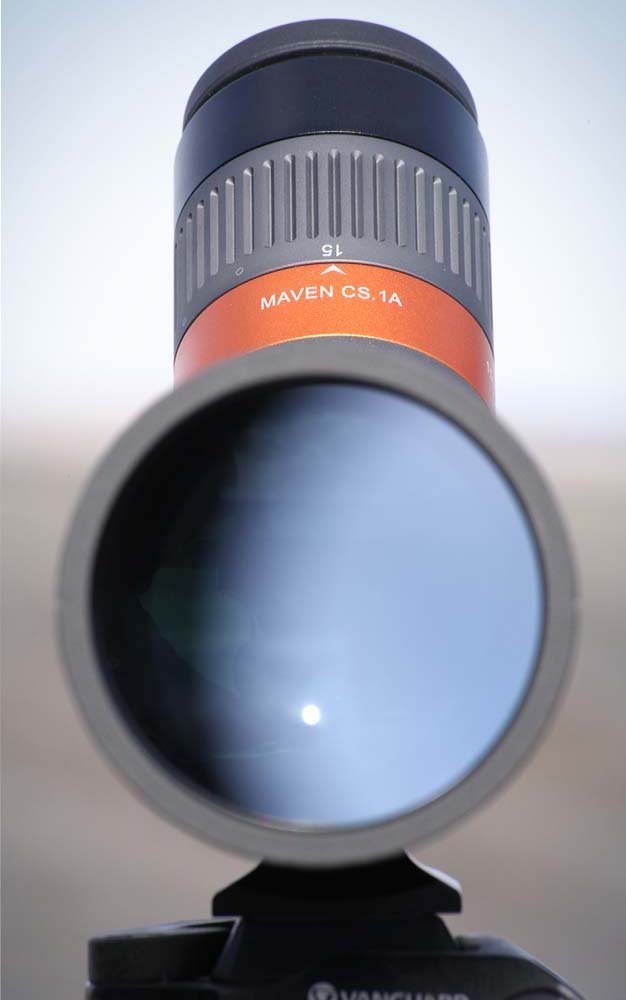
The Maven has especially good manners. Its eyecup turns as though on ball bearings, and instead of locking into pre-determined detents, it is infinitely adjustable. The mid-barrel focus wheel is tight and precise. And the rubber armor is as grippy as it is protective. If we have a ding, it’s the tripod foot, which seems slightly undersized for the frame.
Optically, it’s a solid performer, but its image is like the rest of the spotter, sort of middling. The CS.1 won our low-light test, beating a handful of 80 and 85mm scopes, which is a testament to its good-quality glass. But you won’t be tempted to compare the image delivered by the Maven to that of a Swarovski or Leica. And you might be a little disappointed at how dark and grainy it gets above about 38-power.
The Maven’s eyepiece is fixed, which means you won’t be able to swap out eyepieces for different magnifications. The upside: It’s especially weather- and moisture-proof. The downside: You’re stuck with the 15-45-power zoom. All in, there’s a lot of scope here for $800, a price that represents the savings possible from the direct-to-consumer optics brand.
Why It Made the Cut
A cheerful little spotter that splits the difference between a binocular and a full-sized scope, this optic fits in a coat pocket and would make a great travel companion.
Key Features
- Magnification: 9-27X
- Objective Lens Diameter: 56mm
- Weight: 20.3 ounces
- Length: 7.6 inches
- Field of View at 1,000 Yards: 234-108 feet
- Aluminum-alloy chassis
- Infinitely adjustable eyecup
- 17mm eye relief
Pros
- Extremely lightweight and portable
- Easily fits in backpack or coat pocket
- Useful magnification range
- Sensitive center-barrel focus
Cons
- Feels fragile
- Limited utility without a tripod
Product Description
We’ve seen this design before, most recently from Celestron (with its similarly sized Hummingbird). There’s limited utility for a spotting scope with an objective lens better suited to a full-sized binocular. But the magnification range, zooming from 9x up to 27x, gives this little unit more range and a surprisingly nice image. And its ultra-compact size means you’ll take this optic more places than a larger spotter or a big-boned binocular.
The Nature-Trek has some nice appointments, including the responsive center-barrel focus and the comfortable eyecups. The 45-degree angled eyepiece is also a nice touch, as it allows for users to use it in a number of different stances. At lower powers, you can get by without a stabilizing tripod. But at magnifications above about 18, you’re going to want to mount this, because the shakes introduced by your hands, or an improvised support, blur the image.
Hunters who want a mini optic to pack into the high country, or travelers who want a little more reach than a smaller binocular should consider this little spotting scope.
Why It Made the Cut
A full-size spotter that retails for under $400 should get wide attention, and careful handling. This isn’t the spotter for everyone, but for buyers on a budget who want decent performance and all the reach that a 60-power can deliver, it’s a very good choice.
Key Features
- Magnification: 20-60X
- Objective Lens Diameter: 85mm
- Weight: 70 ounces
- Length: 16.9 inches
- Field of View at 1,000 Yards: 102-48 feet
- Composite chassis
- Mid-barrel focus wheel
- 45-degree angled eyepiece
Pros
- Approachable price
- Relatively light for its dimensions
- 45-degree angle is versatile
- Handsome black-and-green appointments
- Ships with protective nylon cover
Cons
- Gritty focus wheel
- Forgettable glass
Product Description
Athlon submitted two full-sized spotters for this year’s test, but the Argos HD version (as opposed to the Argos G2 UHD) version represents the best combination of price and performance. So much so that it won our Great Buy award as the best bargain spotting scope. We’ve rarely seen this much glass and optical horsepower for under $400.
While this is likely the first spotter that a hunter or shooter may buy—owing to the approachable price—it won’t be the last. That’s because the glass and controls of the Argos HD are slightly disappointing. You’ll notice the images starts to get dark and grainy at about 45-power, and our low-light test confirmed that, compared with its UHD brother, the Argos HD will wink out several minutes before its peers.
Many consumers are understandably confused about the designations that optics companies use to describe the quality of glass in their products, but the Athlon spotters are useful to differentiate between “HD” and “UHD” glass. The first instance stands for “high-definition” while the second is “ultra-high-definition.” There’s still no rigor around those terms, but the HD model was measurably darker and muddier than the UHD model.
Definitions aside, if you’re in the market for a full-sized spotter and have limited funds, consider the Argos HD. You’ll want to ensure that the warranty is up to snuff, but our expectation is that this capable spotter will give you years of adequate service.
Why It Made the Cut
The extra low-dispersion glass in this model and the oversized objective lens make this a good choice for mid-range field work.
Key Features
- Magnification: 20-60X
- Objective Lens Diameter: 68mm
- Weight: 52.7 ounces
- Length: 15.9 inches
- Field of View at 1,000 Yards: 108-60 feet
- Aluminum-alloy and polycarbonate chassis
- Two-speed focus
Pros
- About a pound lighter than its peers
- Sighting aid on the sunshade
- Ships with protective nylon cover
- Long 20mm eye relief
- Double tripod studs in mounting foot
Cons
- Threaded eyepiece adapter can loosen
- Light weight implies durability issues
Product Description
Weighing a full pound less than its similarly sized peers, the Endurance ED would be a good choice for a backcountry hunter who insists on carrying a larger spotter. This Hawke is classified as a mid-sized unit, with its 68mm objective lens diameter, though it has a magnification range more in keeping with 80 and 85mm scopes. It’s a testament to the Hawke’s spotter that it adequately handles all that magnification.
The test team was divided on the merits of the relatively light weight. Half felt it implied a lack of durability. The other half appreciated the Endurance ED’s talents for a backcountry spotter. Because our test doesn’t intentionally punish submissions until they break, the durability question is necessarily unanswered.
We were able to arrive at a consensus on the optical talents of this spotter. The ED glass delivers a bright image that showed only minor color fringing and slight deformity on the very edge of the image at lower powers. We found the usable magnification range extended to about 54-power, which is higher than many of its peers. And we conclude that the price—you should be able to find this retailing for around $650—was fair for the performance.
The controls are tight, and we especially liked the two-speed focus and the fingertip sensitivity of the fine-focus knob. The eyecups and sunshade move with snappy precision. We did notice a fair amount of slop in the threaded eyepiece adapter and would rather see a bayonet mount rather than the threaded ring.
Why It Made the Cut
A big, serious spotter with very good glass and responsive controls, the Ares UHD is the big brother to Athlon’s excellent 65mm Argos introduced a couple of years ago.
Key Features
- Magnification: 20-60X
- Objective Lens Diameter: 80mm
- Weight: 70 ounces
- Length: 16.9 inches
- Field of View at 1,000 Yards: 99-47 feet
- Aluminum alloy chassis
- Mid-barrel focus
Pros
- Athlon’s best grade of glass
- Durable chassis
- Ships with protective nylon cover
- Controls are tight and precise
- Long eye relief
Cons
- Eyepiece is non-removable
- Easy to confuse with HD model
Product Description
There’s nothing particularly ground-breaking in this introduction from Athlon, just a sized-up version of its very good 65mm Ares G2 UHD model. Compared with the HD model, which was also submitted to this year’s test, the UHD version has much better glass and produces an image that’s on par with spotters costing significantly more. That despite an 80mm lens (many of its peers have 85mm objectives).
The other differentiation from the Argos HD model: the aluminum-alloy chassis of the Ares UHD. The build boosts the durability of this spotter and gives it a stiffer and more sure-footed feel. The UHD—it stands for ultra-high-definition—glass also boosts its performance. The Ares G2 placed second in our low-light rankings and turned in very good resolution scores. Testers had some concerns over durability based on how the controls loosened over our testing. And we were a little disappointed in the relatively narrow field of view.
On the other hand, the image delivered by the UHD glass was bright and free of flares and distortion, and the balance and heft of the chassis are both satisfyingly substantial. The question for the market: Is this spotter twice as good as the Argos HD, and is it worth double the cost?
Why It Made the Cut
This pricey, indulgent, magnum-sized optic is the last spotting scope you’ll own, and it parses details like no other spotter in this category.
Key Features
- Magnification: 23-70X
- Objective Lens Diameter: 95mm
- Weight: 73.3 ounces
- Length: 16.1 inches
- Field of View at 1,000 Yards: 176.4-58.5 feet
- LotuTec lens coating
- Dual-speed focus
Pros
- World-class fluorite glass
- Fast, precise focusing
- Surprisingly wide field of view
- Light-gobbling 95mm objective
Cons
- Stratospheric price
- No magnification indexing on eyepiece
Product Description
Once you look through Zeiss’s Harpia spotter, no other scope will quite satisfy you. The image delivered by the 23-70-power eyepiece is stunning, and the amount of light delivered to the eye through the 95mm objective lens makes even low-light glassing a pleasure. The two-speed focus control allows you to riff from close-in to far-distant targets with a single revolution, and then feather the focus for precision. However, at 4.5 pounds, this is a beast to pack, which makes it a better choice for a back deck or base camp optic. And at nearly $4,000, most of us aren’t willing to subject the Harpia to the indignities and dings of the field. That’s too bad, because it’s durable and well-balanced for just about any tripod work.
The Harpia 95 has a little sister, the Harpia 85, that’s a little more portable and only slightly more affordable. But for hunters who aspire to own the best optics on the planet, this line of Zeiss spotters justifies the significant investment.
Why It Made the Cut
Full-sized spotting scopes can cost well over $2,000. At a fraction of that price, this Vortex delivers an adequate image in a durable, versatile package.
Key Features
- Magnification: 20-60X
- Objective Lens Diameter: 85mm
- Weight: 60.9 ounces
- Length: 15.75 inches
- Field of View at 1,000 Yards: 108-60 feet
- Angled eyepiece
- Ships with neoprene cover
- Compatible with Arca-Swiss mounts
Pros
- Entry-level price point
- Retractable sunshade
- Fully-transferable lifetime warranty
Cons
- Image gets dark at high magnifications
- Underwhelming optics
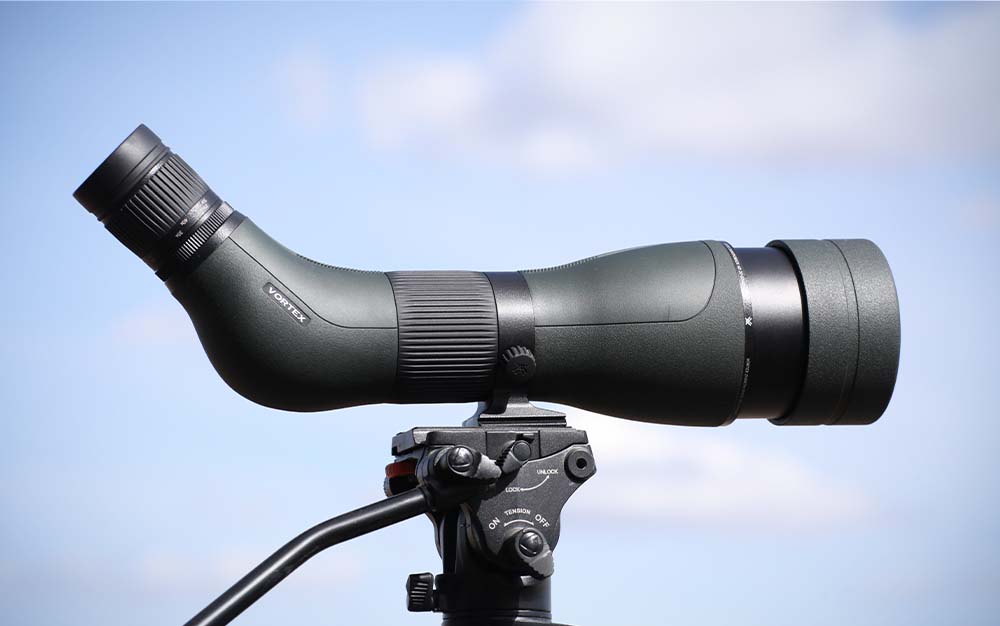
Product Description
This spotter makes an excellent choice for a hunter who wants a versatile spotting scope without paying a month’s wages. The Diamondback HD has decent high-definition glass in the objective lens, but experienced hunters may be disappointed with the clarity and brightness of the image. Its angled body, with rotating tripod ring, allows for infinite adjustment, and the Arca-Swiss compatible tripod system mates up with any number of mounting options.
The Diamondback HD spotter makes an accessible, extremely usable optic for any number of well-lighted conditions. Its optical shortcomings are evident in low light conditions, but that’s to be expected at this bargain price. However, with Vortex’s best-in-class warranty, you’ll never have to worry if it fails to perform.
Why It Made the Cut
Big, grippy, and durable, the Santiam is a no-nonsense full-sized spotter that feels a little heavy for a walk-about optic but will give years of service as a base-camp, shooting-range, or pickup scope.
Key Features
- Magnification: 27-55X
- Objective Lens Diameter: 80mm
- Weight: 68.7 ounces
- Length: 15 inches
- Field of View at 1,000 Yards: 105-73 feet
- Angled eyepiece
- Center-barrel focus
- Highly textured graphite armor
Pros
- Extremely tactile controls
- Lifetime transferable warranty
- Rugged protective armor
Cons
- Eyepiece isn’t removable
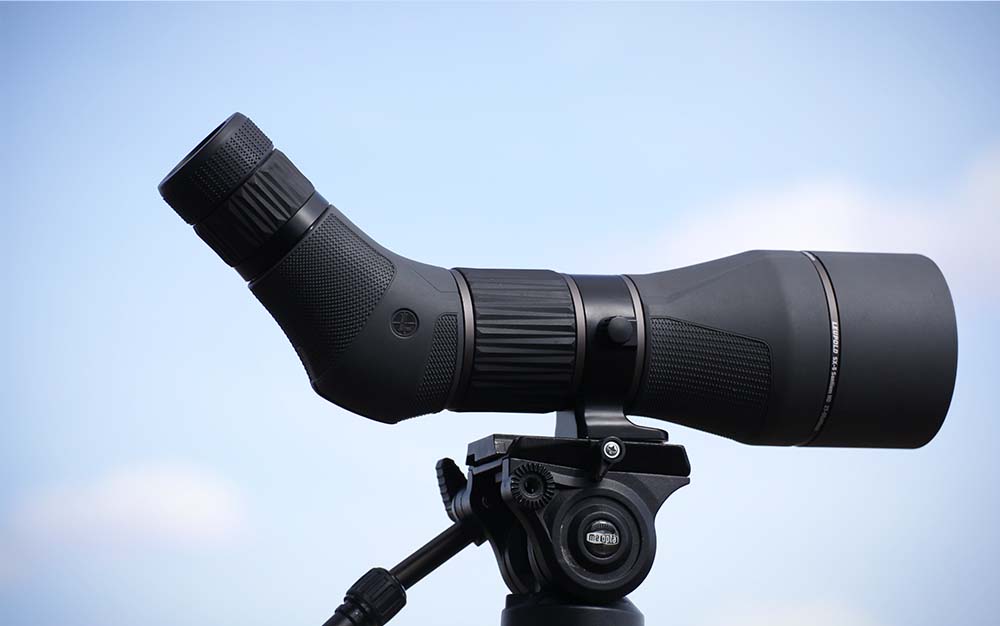
Product Description
Leupold’s flagship spotting scope delivers a quality image at pretty much every magnification. The 27 to 55-power is the sweet spot for combining magnification with a reasonably bright image. At almost 4.3 pounds this spotter feels like a tank, which means it’s a better base-camp scope than a walk-about optic.
This durable one-piece design keeps dust out of the innards but also prevents users from trading out the variable-power eyepiece for a different zoom range or a fixed-power alternative. The rubber is extremely grippy, and the mid-barrel focus allows users to make fine adjustments even while wearing gloves. And if anything happens to it, Leupold’s lifetime transferable warranty will keep you covered.
Why It Made the Cut
This direct-to-consumer brand delivers bright ED glass and quality Japanese build at a relatively accessible price.
Key Features
- Magnification: 27-55X
- Objective Lens Diameter: 80mm
- Weight: 67 ounces
- Length: 15.5 inches
- Field of View at 1,000 Yards: 105-73 feet
- SCHOTT high transmission glass
- Removable eyepiece
- Distinctive graphite armor
- Argon filled
Pros
- Ships with dust-resistant neoprene jacket
- Silky controls
- Interchangeable 22-power eyepiece with MRAD PRS reticle available
- Well-balanced tripod mounting shoe
Cons
- Removable eyepiece design can allow dust and grit to enter body
Product Description
The first spotter from this direct-to-consumer is a versatile powerhouse. The focus, magnification ring, and retractable sunshade all move with silky precision. And the 27-55-power zoom range covers most hunting scenarios, while the 80mm objective lens—made with extra-low dispersion glass—lets in plenty of light. Precision rifle shooters will appreciate the fixed 22-power lens that contains a milling PRS reticle, which allows users to make precise calls when spotting for a long-distance shooter.
Why It Made the Cut
A great all-around spotter, the SIG OSCAR8 has enough optical horsepower for most hunting situations and exterior styling that fits right at home on a rifle range.
Key Features
- Magnification: 27-55X
- Objective Lens Diameter: 80
- Weight: 67.2 ounces
- Length: 15.27 inches
- Field of View at 1,000 Yards: 105-73 feet
- Removable variable-power eyepiece
- Tough, grippy flat dark earth armor
Pros
- Angled eyepiece and rotating tripod collar enables multiple viewing angles
- High-resolution, bright image
- Removable eyepiece can be traded out for other variable or fixed-power eyepieces
- Ships with custom-fit neoprene jacket
Cons
- Center-barrel control is hard to finely focus
Product Description
A handsome, versatile, and rugged spotting scope, the OSCAR8 has a sensibly restrained magnification range that zooms from 27 to 55-power. At low magnifications, the SIG has a bright image and wide field of view. At 40 to 55x, the scope has enough magnification to enable users to count points on a distant buck without making the image maddeningly dark. I hunted with this scope during Montana’s elk season, and it took in stride all the temperature changes, bumps and drops, and dust the hunts dealt it. Should the spotter ever fail, it’s fully backed by SIG’s excellent five-year warranty.
Why It Made the Cut
The Bushnell Elite Tactical LMSS2 is the perfect companion for precision rifle shooting. The integrated reticle allows spotters to communicate to their shooting partner specific holds and call shots with precision and clarity.
Key Features
- Magnification: 8-40X
- Objective Lens Diameter: 60mm
- Weight: 40.7 ounces
- Length: 12.8 inches
- Field of View at 1,000 Yards: 250-50 feet
- Eyepiece contains Horus H-32 milling reticle
- Multiple attachment points for Picatinny rails
- Durable FDE or black armor
Pros
- Reticle matches those in precision riflescopes
- Throw lever makes magnification changes fast
- Slender build easily fits in backpack sleeve
- Utilizes Bushnell’s best glass and coatings
Cons
- Excessively heavy for a 60mm walk-about spotter
Product Description
Purpose-built as an aid to precision rifle shooters, the integrated reticle in the LMSS2 allows spotters to effectively call shots for their teammates on rifle. The straight-style tactical spotter is built like a tank, with double-tough armor and attachment points for Picatinny rails, so you can add accessories like thermals or lights to the optic. Alternatively, the rails allow you to mount the LMSS2 on either rails or a traditional tripod. The ED glass works pretty well, but the real appeal here is the Horus reticle inside and tactical bling on the exterior.
Why It Made the Cut
While there’s no shortage of angled-body spotting scopes, it’s rare to find a premium straight-body-design like the MeoStar S2, and its ability to trade out eyepieces makes it extremely versatile.
Key Features
- Magnification: 30-60X
- Objective Lens Diameter: 82mm
- Weight: 50.4 ounces (without eyepiece)
- Length: 12.8 inches
- Field of View at 1,000 Yards: 144.36-68.9 feet
- Straight-body design
- Interchangeable eyepieces
- Apochromatic objective lens
Pros
- Fast target acquisition
- Excellent glass
- Oversized center-barrel focus easy to turn with gloves
- Select either 20-70x or 30-60x eyepieces
Cons
- Eyepieces purchased separately from body
Product Description
A product-line extension following Meopta’s successful angled MeoStar S2, this 82mm spotter has the optical horsepower for just about any hunting situation, and the straight-barrel design makes it easy to slide into a backpack sleeve. The unit defaults to a 20-70x eyepiece, which you have to purchase separately from the body, but the wide-angle 30-60x eyepiece may have even more utility. That’s because any object you can see at 60x will only darken at 70x, so the additional magnification might not be worth the degradation in image. And the wide-angle eyepiece provides a constant 66-degree field of view throughout the entire magnification range.
The straight-barrel design will appeal to viewers who want to make quick target acquisition, instead of the hunting-and-pecking sometimes required with angled eyepieces. In all, the Meopta compares favorably to premium spotters from Swarovski, Leica, and Zeiss at a lower price.
Why It Made the Cut
In a category with multiple $1,500-and-higher submissions, the Vanguard VEO HD costs less than $400 but will deliver years of service.
Key Features
- Magnification: 20-60X
- Objective Lens Diameter: 80mm
- Weight: 54.7 ounces
- Length: 13.5 inches
- Field of View at 1,000 Yards: 110-52 feet
- Angled eyepiece
- Mid-barrel focus
- Retractable sunshade
Pros
- Accessible price point
- Angled eyepiece and tripod rotation enable wide range of viewing options
- One-piece design minimizes internal dust
Cons
- Slick finish is hard to grip
- Image degrades at higher magnifications
Product Description
Built on a composite-carbon chassis, the Vanguard VEO HD runs lighter than its peers, which makes this 80mm spotter a good choice for backcountry hunting. The angled eyepiece and rotating tripod mount increase its versatility, and the controls are relatively tight and precise, especially for the at around $400.
Demerits include the slippery, non-textured armor and the underwhelming glass, which makes images above about 45-power pretty dark and grainy with some distorted edge detail. Still, if you use this scope in daylight and don’t max out its magnification, it’s a worthy companion for most hunting situations or first-time buyers.
Things to Consider Before Buying a Spotting Scope
The largest, most powerful spotting scopes are among the most expensive sports optics on the market. Big 80 and 85mm scopes from premium brands can cost upwards of $3,000. But even more approachable scopes will set you back around $1,000. That means you need to think about what you want and need a spotter to do.
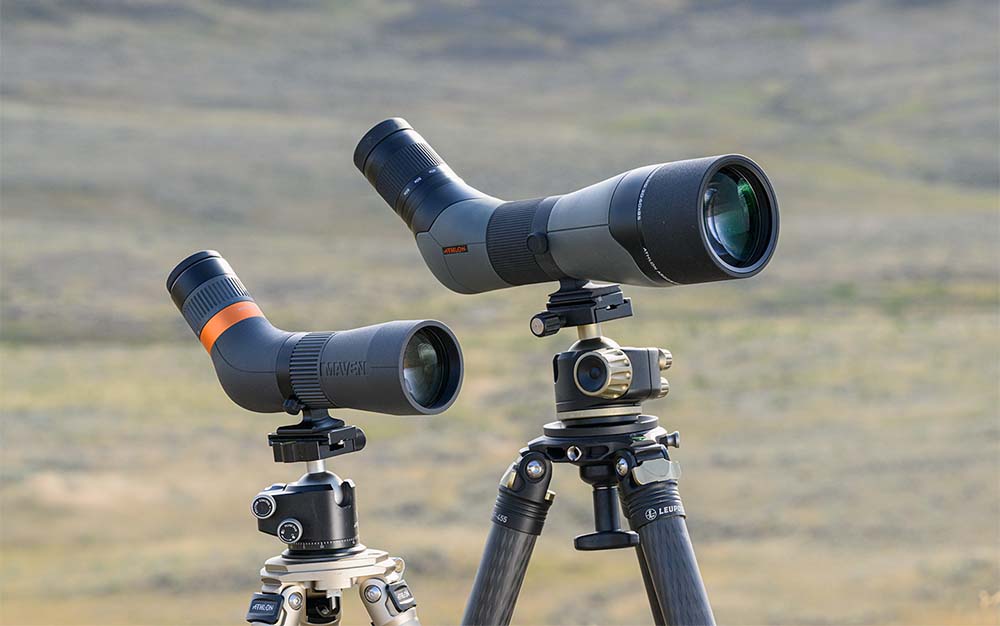
Size
If you want a spotter to carry into the field to help you assess distant game, then consider a mid-sized scope, generally 20-50-power built behind a 65mm objective lens. Or look at even smaller scopes, like the 9-27×56 Hawke in this year’s test. But maybe you want a spotter to mount on a tripod and use from a vantage point. In that case, weight and portability aren’t an issue; you should consider a full-sized scope, with magnification ranges from 20-60-power and an 85 or even 90mm objective lens.
Magnification
Brands make a big deal out of the upper end of the magnification range for their spotters, but that doesn’t mean those higher powers are very useful. Most spotting scopes that zoom up to 60-power get so dark and grainy at that magnification that they’re really only useful up to about 50-power. I mention this because you are likely to get more use out of a spotter with a 20-45-power range than one that claims it goes to 60-power. Especially in low-light conditions, those extreme ranges are rarely usable.
Versatility
How versatile do you want your scope to be? In other words, will you use it just for hunting, or should you consider a model with removable eyepiece so you can trade out wide-angle eyepieces or ones with reticles?
Durability
Consider the durability of a spotter. The most hard-wearing models have oversized controls that can be used with gloved hands, and they are double-sealed against dust, grit, and moisture.
Many buyers are looking for a scope to take to the range to verify hits on distant targets, whether paper bullseyes or steel plates. In those cases, you want a scope that will withstand the abuses of the field. Range spotters often have a reticle in the eyepiece that allows you to call shots for a buddy.
Glass Quality
As you’ll see in the two Athlon scopes in this year’s test, better-quality glass can double the price of a spotter. If you’re spending close to (or upwards of) $1,000 for a spotter, make sure it has either ED (extra-low dispersion) glass.
Ask yourself when you’re most likely to use the optic. Is it to assess distant animals in the first and last light of the day? Or is it to view in the bright light of midday? If the former, you might consider investing in models with excellent glass and mirage-taming coatings. But if it’s the latter, than less expensive glass might be fine.
Tripod Use
Lastly, full-sized spotters are designed to be mounted on a tripod, so consider the mounting hardware. Is the foot large and strong enough to stabilize the optic? Can the tripod adapter be used with a wide variety of tripod models and heads?
FAQs
Q: What is the best magnification for a spotting scope?
The best magnification for a spotting scope depends on how you plan to use it. But generally, the sweet spot between magnification and image quality is somewhere in the middle of the power range. Say you have a 20- to 60-power eyepiece on an 80mm spotter. The best brightness and image quality will be at 20X, but the image will be smallest at that magnification. At 60-power, the image will be largest, but because of the laws of optics, it also appears darkest and grainiest. This same middle-is-best trade-off applies to every magnification range, from 9-27-power spotters to 20-60-power eyepieces.
Q: Is angled or straight better for a spotting scope?
Whether you choose an angled or a straight-body spotting scope is largely a matter of personal preference. Models that have both designs typically have identical glass, magnification ranges, and components, so they’ll likely deliver an identical image. Some users like angled eyepieces because of their versatility. If you’re sitting beside a buddy, you can frame a distant deer, and by simply rotating the barrel, turn the eyepiece to your buddy so they can view the deer. With a straight-body spotting scope, you’d have to trade places with your buddy in order for them to see the deer. However, it can be hard to get your scope on target with an angled eyepiece because the 45-degree angle means the eyepiece isn’t pointing at your target, like a straight-body spotter, so target acquisition occurs much faster.
Q: How are spotting scopes measured?
Spotting scopes are measured with two numbers. The first is the magnification, which generally refers to a range between the lowest and highest magnification. The second number is the size of the objective lens in millimeters. So a 20-60×80 spotter has a 20- to 60-power eyepiece and an 80mm objective lens. A 15-45×65 unit has 15- to 45-power magnification behind a 65mm objective lens.
Q: What distance are spotting scopes good for?
Spotting scopes are good from fairly close to nearly infinity. While the best binoculars for hunting have close focus of about 6 to 8 feet, spotting scopes can only focus to about 12 feet. Spotting scopes work best from mid to far distances. At middle distances, like 50 to 400 yards, you can usually zoom in to see precise details of your target. At longer distances, from 400 yards to infinity, you lose resolution in the magnified image, but you’ll still be able to see details that you could never see with your naked eye or even a binocular.
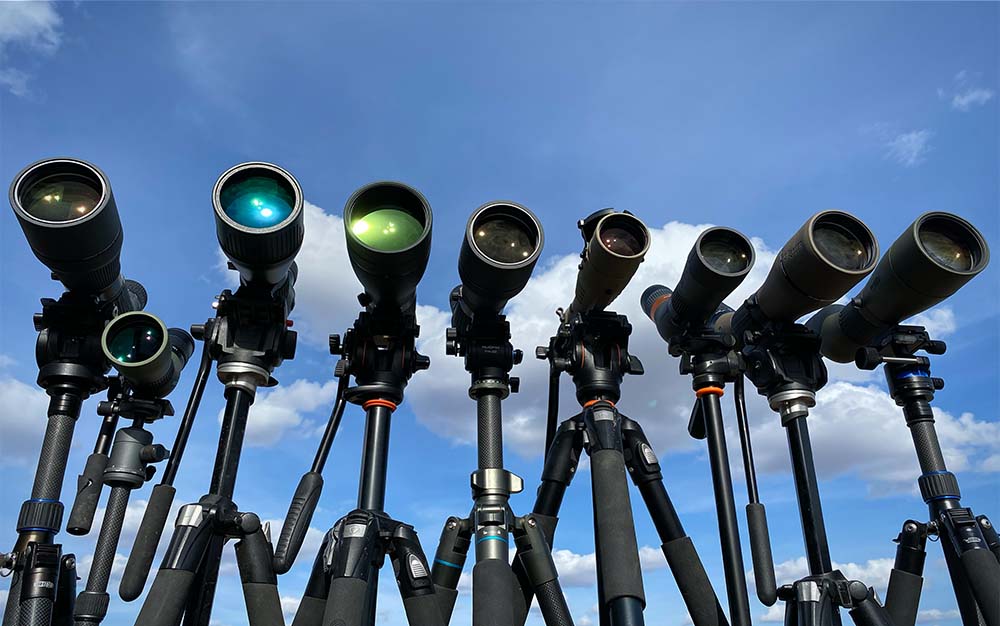
Final Thoughts
Because the best spotting scopes represent a significant investment in money, durability and warranties are both prime considerations. Make sure that the company’s return policy and either repair or replacement will cover your purchase.
How We Tested Spotting Scopes
We test spotting scopes the way you use them—by subjecting them to the rigors and insults of the field. That means dusty days in a pickup and all sorts of conditions mounted to a tripod.
We measure and record the optical attributes—field of view, eye relief, weight, and other specifications—and mount every submission on a tripod suitable for that particular size and weight. We glass near and far targets in all light conditions. We later measure the scopes’ optical resolution, or how finely they render details. And then, we perform a low-light test on several evenings. In this test, we mount all scopes on tripods, set their magnification to 20-power, and then measure how long they can see into the dark, averaging the results to assess performance.
We rate the tightness and precision of their controls, how comfortably the scopes fit our hands and eyes, and then assess their style, versatility, and durability.
The spotter with the highest overall score wins our Editor’s Choice award—this year it went to Maven’s CS.1. But we also assign a Price/Value score to each submission. That’s our opinion of how much of a bargain or a rip-off each binocular is. The optic with the highest Price/Value score wins our Great Buy award. This year that nod goes to Athlon’s Argos HD.

